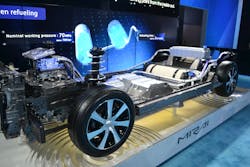University of Extrication: Hydrogen Fuel Cell Vehicles — Part 1
Subject: Fuel Cell Vehicles
Topic: Fuel Cell Vehicle Components
Objective: Identify major components of a hydrogen fuel cell vehicle
Task: Given a fuel cell vehicle for inspection, the rescue team shall identify major components of the hydrogen fuel cell system, including fuel cell stack, electric drive motor(s), hydrogen tanks, hydrogen filler port and high-voltage battery.
As responders are becoming more aware of how to handle incidents involving hybrid and electric plug-in vehicles, the frequency of encountering these types of vehicles at crash or fire incidents is increasing.
The next vehicle type that will soon become more numerous is the hydrogen fuel cell vehicle (FCV). This University of Extrication two-part series provides an overview of the major components of an FCV and explains how these components function. An FCV is designed to use onboard compressed hydrogen to create its own electricity that powers the electric drive motor(s) of the vehicle. It is NOT a hybrid.
Here, we take a close look at the major components of the first mass-produced FCV, the Toyota Mirai.
Next month, we’ll look at an actual Mirai vehicle as it is currently available for sale, review its major features, and explain essential fire and rescue operations for an incident involving an FCV.
Components of the Toyota Mirai FCV
- Two 10,000-psi hydrogen fuel tanks
- A 123-pound fuel cell stack
- One 12-volt battery
- One high-voltage battery

Ron Moore
RON MOORE, who is a Firehouse contributing editor, recently retired as a division chief with the McKinney, TX, Fire Department and now serves with Prosper, TX, Fire Rescue. He self-published the Vehicle Rescue 1-2-3 training manual and serves as the forum moderator for the extrication section of Firehouse.com . Moore can be contacted directly at [email protected].






